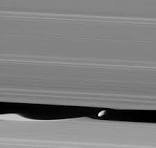A black hole is a massive, compact astronomical object so dense that its gravity prevents anything—even light—from escaping. Albert Einstein’s theory of general relativity predicts that a sufficiently compact mass will form a black hole. The boundary beyond which nothing can escape is called the event horizon.
While a black hole has a profound effect on objects that cross this boundary, it has no locally detectable features according to general relativity. In many ways, a black hole behaves like an ideal black body, reflecting no light. According to quantum field theory in curved spacetime, event horizons emit Hawking radiation, which has the same spectrum as black body radiation, with a temperature inversely proportional to the black hole’s mass. For stellar-mass black holes, this temperature is on the order of billionths of a kelvin, making it essentially impossible to observe directly.
The idea of objects whose gravitational pull is too strong for light to escape was first proposed in the 18th century by John Michell and Pierre-Simon Laplace. In 1916, Karl Schwarzschild found the first modern solution to Einstein’s field equations of general relativity that describes a black hole. This solution is now known as the Schwarzschild metric. In 1958, David Finkelstein was the first to interpret a black hole as a region of space from which nothing can escape.
For a long time, black holes were considered a mere mathematical curiosity. It wasn’t until the 1960s that theoretical work demonstrated they are a generic and inevitable prediction of general relativity. The first black hole to be widely accepted as real was Cygnus X-1, identified independently by several researchers in 1971.
Black holes typically form when massive stars collapse at the end of their life cycle. Once formed, a black hole can grow by absorbing mass from its surroundings. Supermassive black holes, with millions or even billions of times the mass of the Sun, are thought to form by absorbing stars, merging with other black holes, or through the direct collapse of massive gas clouds. There is now a scientific consensus that most galaxies, including our own Milky Way, contain supermassive black holes at their centers.








